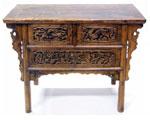TABLES
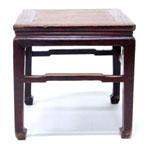
During the early periods of Chinese history when people lived at the mat low tables were used for day to day needs. The move to the chair dramatically changed the way people lived.
One such change related to dining. At home or in a restaurant people gathered for meals around a central table. The most popular were called “Eight Immortal” tables, a reference to the group of figures representing a wish for long life as well as indicating that eight people could be comfortably seated. In addition to dining the table was used for preparing meals, serving refreshments and playing games. The table is the centre of attention for family and friends to enjoy each other’s company.
The perfect companion to the dining table is the “jiu zhuo” or wine table. Placed to the side it held wine and food that could be brought to the diners as requested. Curiously, the Chinese did not employ large rectangular dining tables for serving groups as occurred in other cultures. Paintings of Chinese banquet scenes generally show the small wine table being used for individual diners who would be served by personal servants.
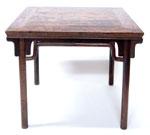
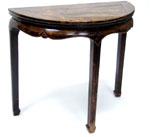
It has been suggested that the shift to the chair raised the height of windows. This in turn resulted in more wall space and areas to place furniture such as cabinets and tables. The semi-round or half moon table was created for this space. This type of table was primarily a display table. Another style was to have two half moon tables that could come together to form a circle to be used as either a central display table or meeting place.
In Chinese society a person’s status was identified by their position in the room. The family heads sat in the most central position while to their front and sides were lines for other family members. Between the chairs of the heads of the family stood a large ceremonial table. While slightly smaller than a dining table it had large aprons and was carved on all four sides with auspicious symbols.
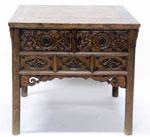

The long narrow table with inverted ends is a quintessential piece of Chinese furniture. Its origins can be traced back over 2500 years when they were used for religious purposes. The table continued to be used to hold ancestral tablets or figures of other deities. Another major role was to display art and calligraphy or hold porcelain, jade and stone.
Those without the turned up ends were often used to hold the long musical instrument called a “qin”. The qin is an ancient long seven stringed instrument. It is the most respected musical instrument and is one of the Four Arts scholars were expected to study. The others are qi (better known in the West by the Japanese name of Go), calligraphy and painting.
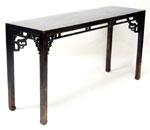

Large rectangular tables are known as painting tables. These were an essential item in the scholar’s studio who used it to practise art and calligraphy. As such they were often a quite refined piece of furniture reflecting the taste of the studio’s occupant. Painting tables are usually taller than dining tables and have clear leg room so that the person could move freely around the table and work comfortably while standing up.
Tables with drawers were also extensively used in the home where they could serve as altars, display tables or bedroom furniture. The deep long drawers were ideal for storage.
Many, like this piece were richly carved with auspicious designs wishing for a long and prosperous life. The quality of the carving showed the deep held passion for a fruitful life as well as the attachment towards motifs representing these ambitions.
